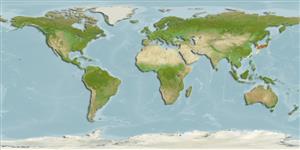Actinopterygii (ray-finned fishes) >
Syngnathiformes (Pipefishes and seahorses) >
Syngnathidae (Pipefishes and seahorses) > Hippocampinae
Etymology: Hippocampus: Greek, ippos = horse + Greek,kampe = curvature (Ref. 45335). More on author: Temminck, Schlegel.
Environment / Climate / Range
Ecology
Marine; demersal; non-migratory. Subtropical, preferred ?
Northwest Pacific: Endemic to Japan. This name has been misapplied to Hippocampus sindonis (Ref. 30915). International trade is monitored through a licensing system (CITES II, since 5.15.04) and a minimum size of 10 cm applies.
Length at first maturity / Size / Weight / Age
Maturity: Lm 6.0 range ? - ? cm
Max length : 10.8 cm SL male/unsexed; (Ref. 36318); common length : 6.0 cm TL male/unsexed; (Ref. 559)
Short description
Morphology | Morphometrics
Inhabits Sargassum belts near shore. Used in Chinese medicine (Ref. 12166). Length type OT refers to height (= TL - head length). Ovoviviparous (Ref. 205). The male carries the eggs in a brood pouch which is found under the tail (Ref. 205).
Male carries the eggs in a brood pouch (Ref. 205).
Lourie, S.A., A.C.J. Vincent and H.J. Hall, 1999. Seahorses: an identification guide to the world's species and their conservation. Project Seahorse, London. 214 p. (Ref. 30915)
IUCN Red List Status (Ref. 115185)
Threat to humans
Harmless
Human uses
More information
Age/SizeGrowthLength-weightLength-lengthLength-frequenciesMorphometricsMorphologyLarvaeLarval dynamicsRecruitmentAbundance
ReferencesAquacultureAquaculture profileStrainsGeneticsAllele frequenciesHeritabilityDiseasesProcessingMass conversion
Tools
Special reports
Download XML
Internet sources
